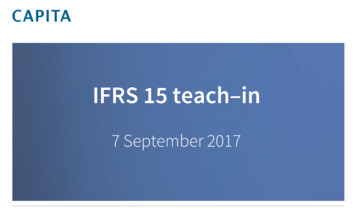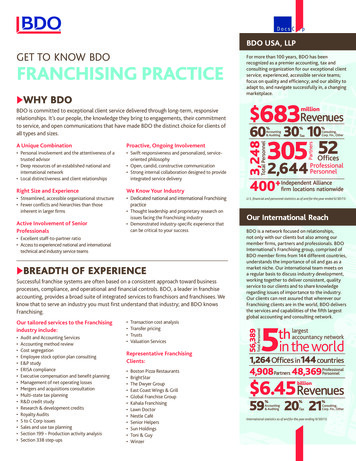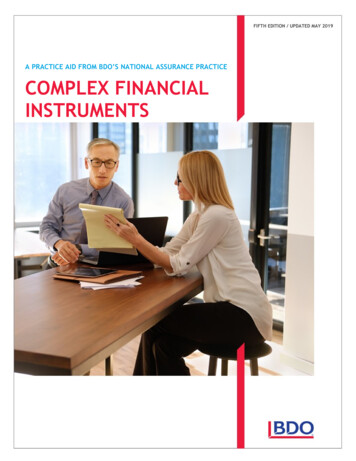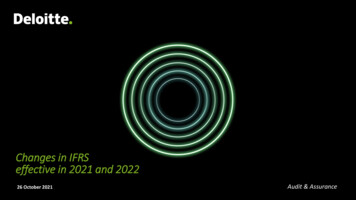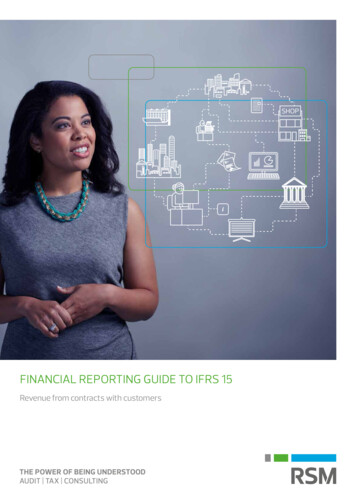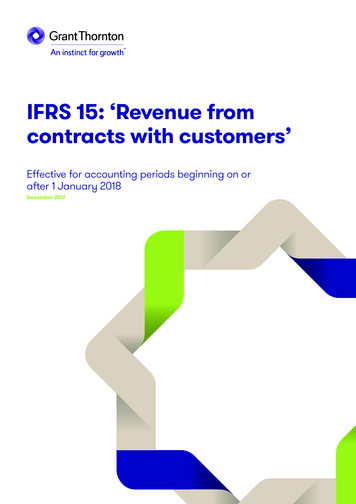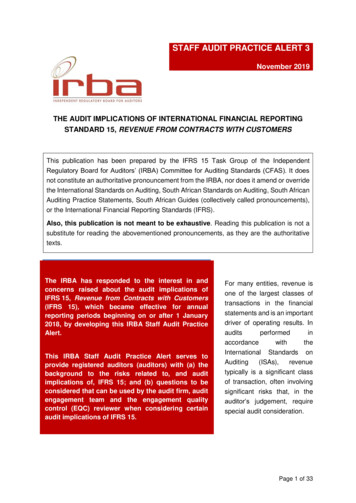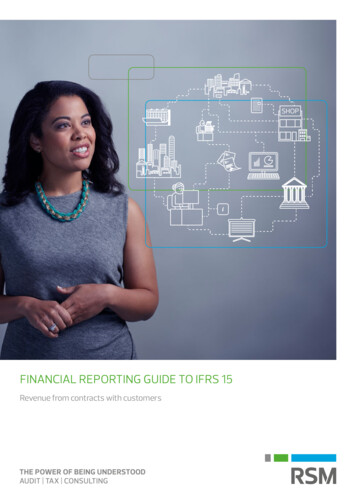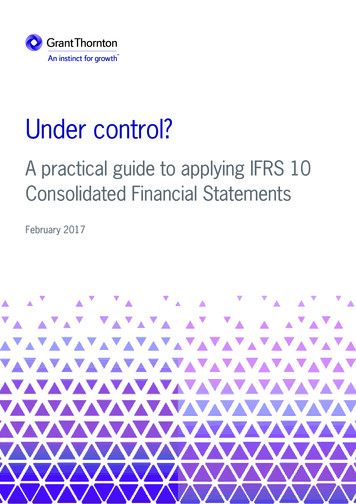
Transcription
IFRS AT A GLANCEAs at 31 December 2020
IFRS at a Glance (IAAG) has been compiled to assist in gaining ahigh level overview of International Financial ReportingStandards (IFRSs), including International Accounting Standardsand Interpretations.IAAG includes all IFRSs in issue as at 31 December 2020.If a Standard or Interpretation has been revised with a futureeffective date, the revised requirement has also been includedand is identified by an (R) suffix.2
Table of contentsIFRS 1 FIRST-TIME ADOPTION OF IFRSsIFRS 2 SHARE-BASED PAYMENTIFRS 3 BUSINESS COMBINATIONSIFRS 4 INSURANCE CONTRACTSIFRS 5 NON-CURRENT ASSETS HELD FOR SALE AND DISCONTINUED OPERATIONSIFRS 6 EXPLORATION FOR AND EVALUATION OF MINERAL RESOURCESIFRS 7 FINANCIAL INSTRUMENTS: DISCLOSURESIFRS 8 OPERATING SEGMENTSIFRS 9 FINANCIAL INSTRUMENTSIFRS 10 CONSOLIDATED FINANCIAL STATEMENTSIFRS 11 JOINT ARRANGEMENTSIFRS 12 DISCLOSURE OF INTERESTS IN OTHER ENTITIESIFRS 13 FAIR VALUE MEASUREMENTIFRS 14 REGULATORY DEFERRAL ACCOUNTSIFRS 15 REVENUE FROM CONTRACTS WITH CUSTOMERSIFRS 16 LEASESIFRS 17 INSURANCE CONTRACTSIAS 1 PRESENTATION OF FINANCIAL STATEMENTSIAS 2 INVENTORIESIAS 7 STATEMENT OF CASH FLOWSIAS 8 ACCOUNTING POLICIES, CHANGES IN ACCOUNTING ESTIMATES AND ERRORSIAS 10 EVENTS AFTER THE REPORTING PERIODIAS 12 INCOME TAXESIAS 16 PROPERTY, PLANT AND EQUIPMENTIAS 19 EMPLOYEE BENEFITSIAS 20 GOVERNMENT GRANTSIAS 21 THE EFFECTS OF CHANGES IN FOREIGN EXCHANGE RATESIAS 23 BORROWING COSTSIAS 24 RELATED PARTY DISCLOSURESIAS 26 ACCOUNTING AND REPORTING BY RETIREMENT BENEFIT PLANSIAS 27 SEPARATE FINANCIAL STATEMENTSIAS 28 INVESTMENTS IN ASSOCIATES AND JOINT VENTURESIAS 29 FINANCIAL REPORTING IN HYPERINFLATIONARY ECONOMIESIAS 32 FINANCIAL INSTRUMENTS: PRESENTATIONIAS 33 EARNINGS PER SHAREIAS 34 INTERIM FINANCIAL REPORTINGIAS 36 IMPAIRMENT OF ASSETSIAS 37 PROVISIONS, CONTINGENT LIABILITIES AND CONTINGENT 697173747576787981848788899193IAS 38 INTANGIBLE ASSETSIAS 39 FINANCIAL INSTRUMENTS: RECOGNITION AND MEASUREMENTIAS 40 INVESTMENT PROPERTYIAS 41 AGRICULTUREIFRIC 1 CHANGES IN EXISTING DECOMMISSIONING, RESTORATION AND SIMILAR LIABILITIESIFRIC 2 MEMBERS’ SHARES IN CO-OPERATIVE ENTITIES AND SIMILAR INSTRUMENTSIFRIC 5 RIGHTS TO INTERESTS ARISING FROM DECOMMISSIONING, RESTORATION AND ENVIRONMENTALREHABILITATION FUNDSIFRIC 6 LIABILITIES ARISING FROM PARTICIPATING IN A SPECIFIC MARKET: WASTE ELECTRICAL ANDELECTRONIC EQUIPMENTIFRIC 7 APPLYING THE RESTATEMENT APPROACH UNDER IAS 29 FINANCIAL REPORTING INHYPERINFLATIONARY ECONOMIESIFRIC 9 REASSESSMENT OF EMBEDDED DERIVATIVESIFRIC 10 INTERIM FINANCIAL REPORTING AND IMPAIRMENTIFRIC 12 SERVICE CONCESSION ARRANGEMENTSIFRIC 14 IAS 19: THE LIMIT ON A DEFINED BENEFIT ASSET, MINIMUM FUNDING REQUIREMENTS AND THEIRINTERACTIONIFRIC 16 HEDGES OF A NET INVESTMENT IN A FOREIGN OPERATIONIFRIC 17 DISTRIBUTION OF NON-CASH ASSETS TO OWNERSIFRIC 19 EXTINGUISHING FINANCIAL LIABILITIES WITH EQUITY INSTRUMENTSIFRIC 20 STRIPPING COSTS IN THE PRODUCTION PHASE OF A SURFACE MINEIFRIC 21 LEVIESIFRIC 22 FOREIGN CURRENCY TRANSACTIONS AND ADVANCE CONSIDERATIONIFRIC 23 UNCERTAINTY OVER INCOME TAX TREATMENTSSIC-7 INTRODUCTION OF THE EUROSIC-10 GOVERNMENT ASSISTANCE: NO SPECIFIC RELATION TO OPERATING ACTIVITIESSIC-25 INCOME TAXES: CHANGES IN THE TAX STATUS OF AN ENTITY OR ITS SHAREHOLDERSSIC-29 SERVICE CONCESSION ARRANGEMENTS: DISCLOSURESIC-32 INTANGIBLE ASSETS: WEBSITE 9120121123124126127128129130
Effective DatePeriods beginning on or after 1 July 2009Page 1 of 2IFRS 1 First-time Adoption of IFRSsSCOPE IFRS 1 does not apply to entities already reporting under IFRSsGENERAL REQUIREMENTS IFRS 1 applies to the first set of financial statements that contain an explicit and unreservedstatement of compliance with IFRSsIFRS 1 applies to any interim financial statements for a period covered by those firstfinancial statements that are prepared under IFRSs.‒ IFRSs that are currently effective; or‒ One or more IFRSs that are not yet effective, if those new IFRS permit early adoption. 4Select IFRS accounting policies using either:Recognise/derecognise assets and liabilities where necessary so as to comply with IFRSsReclassify items that the entity recognised under previous accounting framework as one typeof asset, liability or component of equity, but are a different type of asset, liability orcomponent of equity under IFRSApply IFRSs in measuring all recognised assets and liabilities.
Effective DatePeriods beginning on or after 1 July 2009Page 2 of 2IFRS 1 First-time Adoption of IFRSsRECOGNITION AND MEASUREMENTOPTIONAL EXEMPTIONSMANDATORY EXCEPTIONSIFRS 1 does not permit these to be applied by analogyto other itemsAn entity may elect to use one or more of the following exemptions,which provide specific relief, on adoption of IFRSs: Business combinations Share-based payment transactions Insurance contracts Fair value or revaluation as deemed cost Use of revalued amount as deemed cost for ‘event driven fairvalues’ between transition date and date of the first IFRSs reportingperiod Deemed cost for assets used in operations subjectto rate regulation Leases Cumulative translation differences Investments in subsidiaries, joint ventures and associates Assets and liabilities of subsidiaries, associates and joint ventures Compound financial instruments Designation of previously recognised financial instruments Fair value measurement of financial assets/liabilities at initialrecognition Decommissioning liabilities included in the cost of property,plant and equipment Financial assets or intangible assets accounted for in accordancewith IFRIC 12 Service Concession Arrangements Borrowing costs Extinguishing financial liabilities with equity instruments accountedfor in accordance with IFRIC 19 -Extinguishing Financial Liabilitieswith Equity Instruments Joint arrangements Severe hyperinflation Government loans Stripping costs in the production phase of a surface mine inaccordance with IFRIC 20 Stripping Costs in the Production Phaseof a Surface Mine.IFRS 1 prohibits retrospective application in relation to the following: Estimates Derecognition of financial assets and financial liabilities Hedge accounting Non-controlling interests.5OPENING IFRS STATEMENT OF FINANCIAL POSITION An opening IFRS Statement of Financial Position is prepared at the date of transitionAll IFRSs are applied consistently across all reporting periods in the entity’s first setof IFRS compliant financial statements (i.e. both the comparatives and the currentreporting period)If a standard is not yet mandatory but permits early application, an entity is permitted,but not required, to apply that Standard in its first IFRS set of financial statements.ACCOUNTING POLICIESPRESENTATION AND DISCLOSUREUse the same accounting policies in the opening IFRS statement offinancial position and throughout all periods presented in the firstIFRS financial statements Those accounting policies have to comply with each IFRS effectiveat the end of the first IFRS reporting period.Changes in accounting policies during first year of IFRSIf, between the date of an entity’s interim financial report (preparedin accordance with IAS 34 Interim Financial Reporting) and the issueof its first annual IFRS financial statements, and entity changesaccounting policies and/or adopts exemptions: The requirements of IAS 8 Accounting Policies, Changesin Accounting Estimates and Errors do not apply The reconciliation between IFRSs and previous GAAP hasto be updated.An entity’s first set of financial statements are required to present at least three statementsof financial position and two statements each of statements of comprehensive income,income statements (if presented), statements of cash flows and statements of changesin equity, related notes and in relation to the adoption of IFRSs, the following: A reconciliation of equity reported under previous accounting framework to equityunder IFRSs:‒ At the date of transition to IFRSs‒ At the end of the latest period presented in the entity’s most recent annual financialstatements under previous accounting framework. A reconciliation of total comprehensive income reported under previous accountingframework to total comprehensive income under IFRSs for the entity’s most recent annualfinancial statements under previous accounting framework Interim financial reports:‒ In addition to the reconciliations above, the entity is also required to provide:‒ A reconciliation of equity reported under its previous accounting frameworkto equity under IFRSs at the end of the comparable interim period, and‒ A reconciliation of total comprehensive income reported under its previous accountingframework to total comprehensive income under IFRSs for the comparative interimperiod, and‒ Explanations of the transition from its previous accounting framework to IFRS. Any errors made under the previous accounting framework must be separatelydistinguished Additional disclosure requirements are set out in IFRS 1. REPEAT APPLICATION OF IFRS 1An entity that has applied IFRSs in a previous reporting period, butwhose most recent previous annual financial statements do notcontain an explicit and unreserved statement of compliance withIFRSs, must either apply IFRS 1 or else apply IFRSs retrospectively inaccordance with IAS 8 Accounting Policies, Changes in AccountingEstimates and Errors.
Effective DatePeriods beginning on or after 1 January 2005Page 1 of 2IFRS 2 Share-based PaymentSCOPEIFRS 2 applies to all share-based payment transactions, which are defined as follows: Equity-settled, in which the entity receives goods or services as consideration forequity instruments of the entity (including shares or share options);Cash-settled, in which the entity receives goods or services by incurring a liability tothe supplier that is based on the price (or value) of the entity's shares or other equityinstruments of the entityTransactions in which the entity receives goods or services and either the entity or thesupplier of those goods or services have a choice of settling the transaction in cash (orother assets) or equity instruments.IFRS 2 also applies: To transfers by shareholders to parties (includingemployees) that have transferred goods or services tothe entity. This would include transfers of equityinstruments of the entity or fellow subsidiaries by theentity's parent entity to parties that have provided goodsand servicesWhen an entity does not receive any specificallyidentifiable goods/services.IFRS 2 does not apply to: Transactions in which the entity acquires goods as part of the net assets acquired in abusiness combination to which IFRS 3 Business Combinations applies or to thecontribution of a business on the formation of a joint venture to which IFRS 11 JointArrangements appliesShare-based payment transactions in which the entity receives or acquires goods orservices under a contract within the scope of IAS 32 Financial Instruments: Presentationand IFRS 9 Financial InstrumentsTransactions with an employee in his/her capacity as a holder of equity instruments.IDENTIFYING THE SHARE-BASED PAYMENT CONDITIONSRECOGNITIONVESTING CONDITIONSA condition that determines whether the entity receives the services that entitle the counterparty to receive the share-based payment and is either: a service condition, or aperformance condition.SERVICE CONDITIONPERFORMANCE CONDITIONRequires the counterparty tocomplete a specified periodof service during whichservices are provided to theentity. If the counterparty,regardless of the reason,ceases to provide serviceduring the vesting period, ithas failed to satisfy thecondition. A performancetarget is not required to bemet.Requires: The counterparty to complete a specified period of service (i.e. service condition) - the service requirement can be explicit or implicit, and Specified performance target(s) to be met while the counterparty is rendering that service.The period of achieving the performance target(s): Shall not extend beyond the end of the service period, and May start before the service period on the condition that the commencement date of the performance target is not substantially before thecommencement of the service period.A performance target is defined by reference to: The entity's own operations (or activities) or the operations or activities of another entity in the same group (ie a non-market condition), or The price (or value) of the entity's equity instruments or the equity instruments of another entity in the same group (including shares andshare options) (ie a market condition).A performance target might relate either to the performance of the entity as a whole or to some part of the entity (or part of the group), suchas a division or an individual employee.NON-VESTINGCONDITIONSA condition thatdetermines whether theentity receives theservices that entitle thecounterparty to receivethe share-based paymentand is either: a servicecondition, or aperformance condition. 6Excluded from grant date fairvalue calculationAdjustment to the number ofshares and/or vesting dateamount for actual results.NON-MARKET CONDITIONMARKET CONDITIONRelates to operations of the entity or to theoperations of another entity in the same group.I Performance condition, upon which the exercise price, the vesting or exercisability ofan equity instrument depends, that is related to the market price of the entity's equityinstruments (including share options) or those of another entity within the group. Included in the grantdate fair valuecalculationNo adjustment to thenumber of shares orvesting date amountfor actual results.Recognise the goods orservices received oracquired in a sharebased paymenttransaction when thegoods are obtained or asthe services are receivedRecognise an increase inequity for an equitysettled share-basedpayment transactionRecognise a liability fora cash-settled sharebased paymenttransactionWhen the goods orservices received oracquired do not qualifyfor recognition as assets,recognise an expense.
Effective DatePeriods beginning on or after 1 January 2005Page 2 of 2IFRS 2 Share-based PaymentMEASUREMENTEQUITY-SETTLEDTransactions with employees 7Measure at the fair value ofthe equity instruments grantedat grant dateThe fair value is neverremeasuredThe grant date fair value isrecognised over the vestingperiod.Transactions with nonemployees Measure at the fair value ofthe goods or services receivedat the date the entity obtainsthe goods or receives theserviceIf the fair value of the goodsor services received cannot beestimated reliably, measure byreference to the fair value ofthe equity instrumentsgranted.CHOICE OF SETTLEMENTShare-based payment transactions where thereis a choice of settlement If the counterparty has the right to choosewhether a share-based payment transaction issettled in cash or by issuing equity instruments,the entity has granted a compound instrument(a cash-settled component and an equitysettled component)If the entity has the choice of whether to settlein cash or by issuing equity instruments, theentity shall determine whether it has a presentobligation to settle in cash and account for thetransaction as cash-settled or if no suchobligation exists, account for the transaction asequity-settled.CASH-SETTLEDCash-settled share-basedpayment transactions Measure the liability at thefair value at grant dateRe-measure the fair value ofthe liability at each reportingdate and at the date ofsettlement, with any changesin fair value recognised inprofit or loss for the periodLiability is recognised overthe vesting period (ifapplicable).GROUP SETTLED SHARE-BASED PAYMENTSAn entity that receives goods or services(receiving entity) in an equity-settled or acash-settled share-based paymenttransaction is required to account for thetransaction in its separate or individualfinancial statements. The entity receiving the goods or servicesrecognises them, regardless of whichentity settles the transaction, this must beon an equity-settled or a cash-settled basisassessed from the entities own perspective(this might not be the same as the amountrecognised by the consolidated group)The term 'group' has the same definition asper IFRS 10 Consolidated FinancialStatements that it includes only a parentand its subsidiaries.
Effective DatePeriods beginning on or after 1 July 2009Page 1 of 2IFRS 3 Business CombinationsSCOPE / IDENTIFYING A BUSINESS COMBINATIONA business combination is:Transaction or event in which acquirer obtains control over a business (e.g. acquisition of shares ornet assets, legal mergers, reverse acquisitions).IFRS 3 does not apply to: The accounting for the formation of a joint arrangement in the financial statements of the jointarrangement itself. Acquisition of an asset or group of assets that is not a business. A combination of entities or businesses under common control.Definition of “control of an investee”An investor controls an investee when the investor is exposed, or has rights, to variable returns from its involvement with t he investee and has the ability to affect those returns through its power over theinvestee.Power: when existing rights give an investor the current ability to direct the relevant activities of an investee (ie the activities that significantly affect the investee’s returns)Rights to variable returns: an investor is exposed or has rights to returns that vary as a result of the investee’s performanceLink between power and returns: control exists when an investor has power over an investee and exposure or rights to the investee’s variable returns, and has the ability to use its power to affect theinvestee’s returns.Principal or agent: an investor with power over an investee determines whether it is a principal or an agent. An investor that is an agent does not control an investee when it exercises delegated rights.Definition of a “Business”An Integrated set of activities and assets that is capable of being conducted and managed for the purpose of providing goods or services to customers, generating investment income (such as dividends orinterest) or generating other income from ordinary activities.8
Effective DatePeriods beginning on or after 1 July 2009Page 2 of 2IFRS 3 Business CombinationsTHE ACQUISITION METHODA business combination must be accounted for by applying the acquisition method.STEP 1: IDENTIFYING THEACQUIRERSTEP 2: DETERMINING THEACQUISITION DATEIFRS 10 Consolidated Financial Statementsis used to identify the acquirer – the entitythat obtains control of the acquiree.The date which the acquirer obtainscontrol of the acquiree.STEP 3: RECOGNISING AND MEASURING THEIDENTIFIABLE ASSETS ACQUIRED, THE LIABILITIESASSUMED AND ANY NON-CONTROLLING INTEREST(NCI) IN THE ACQUIREE STEP 4: RECOGNISING AND MEASURING GOODWILL OR A GAIN FROMBARGAIN PURCHASE Goodwill is recognised as the excess between:‒ The aggregate of the consideration transferred, any non-controlling interest in theacquiree and, in a business combination achieved in stages, the acquisition-date fairvalue of the acquirer’s previously held equity interest in the acquiree‒ The identifiable net assets acquired (including any deferred tax balances)Goodwill can be grossed up to include the amounts attributable to NCI, which is thecase when NCI is measured at their acquisition date fair value.A gain from a bargain purchase is immediately recognised in profit or lossThe consideration transferred in a business combination (including any contingentconsideration) is measured at fair valueContingent consideration is either classified as a liability or an equity instrument on thebasis of IAS 32 Financial InstrumentsContingent consideration that is within the scope of IFRS 9 (classified as a financial liability)needs to be remeasured at fair value at each reporting date with changes reported in profitor loss.MEASUREMENT PERIODApplies when initial accounting is incomplete at the end of thereporting period in which the business combination occursMeasurement period ends when acquirer receives informationseeking about facts and circumstances at acquisition date, notto exceed one year from acquisition date.9 As of the acquisition date, the acquirer recognises,separately from goodwill:‒ The identifiable assets acquired‒ The liabilities assumed‒ Any NCI in the acquireeThe acquired assets and liabilities are required to bemeasured at their acquisition-date fair valuesThere are certain exceptions to the recognition and/ormeasurement principles which cover contingentliabilities, income taxes, employee benefits,indemnification assets, reacquired rights, share-basedpayments and assets held for sale.NCI that represent ownership interests and entitle theirholders to a proportionate share of the entity’s netassets in the event of liquidation (e.g. shares) aremeasured at acquisition-date fair value or at the NCI’sproportionate share in net assetsAll other components of NCI (e.g. from IFRS 2 Sharebased payments or calls) are required to be measuredat their acquisition-date fair values.DETERMINING WHAT IS PART OF THE BUSINESS COMBINATIONTRANSACTIONThe acquirer should consider if the consideration includes amounts attributable toother transactions within the contract (pre-existing relationship, arrangements thatremunerate employees etc.).Acquisition and other costs Cannot be capitalised, must instead be expensed in the period they are incurred Costs to issue debt or equity are recognised in accordance with IAS 32 and IFRS 9.ADDITIONAL GUIDANCE FOR APPLYING THE ACQUISITION METHOD TOPARTICULAR TYPES OF BUSINESS COMBINATIONSBUSINESS COMBINATION ACHIEVED IN STAGES An acquirer sometimes obtains control of an acquiree in which it held an equityinterest immediately before the acquisition date. This is known as a businesscombination achieved in stages or as a step acquisitionObtaining control triggers re-measurement of previous investments (equityinterests)The acquirer remeasures its previously held equity interest in the acquiree at itsacquisition-date fair value. Any resulting gain/loss is recognised in profit or loss.BUSINESS COMBINATION ACHIEVED WITHOUT TRANSFER OFCONSIDERATION The acquisition method of accounting for a business combination also applies if noconsideration is transferred.Such circumstances include:‒ The acquiree repurchases a sufficient number of its own shares for an existinginvestor (the acquirer) to obtain control‒ Minority veto rights lapse that previously kept the acquirer from controlling anacquiree in which the acquirer held the majority voting rights‒ The acquirer and the acquiree agree to combine their businesses by contract alone.SUBSEQUENT MEASUREMENT AND ACCOUNTING In general, after the date of a business combination an acquirer measures andaccounts for assets acquired and liabilities assumed or incurred in accordance withother applicable IFRSs.However, IFRS 3 includes accounting requirements for reacquired rights,contingent liabilities, contingent consideration and indemnification assets.
Effective DatePeriods beginning on or after 1 January 2005IFRS 4 Insurance ContractsSCOPEThis Standard appliesto: Insurance contractsthat an entity issuesand reinsurancecontracts that itholdsFinancialinstruments that anentity issues with adiscretionaryparticipationfeature.If insurance contractsinclude a depositcomponent,unbundling may berequired.The following are examples of contracts that are insurance contracts, if the transfer of insurance risk is significant: Insurance against theft or damage to propertyInsurance against product liability, professional liability, civil liability or legal expensesLife insurance and prepaid funeral expensesLife-contingent annuities and pensionsDisability and medical coverSurety bonds, fidelity bonds, performance bonds and bid bondsCredit insurance that provides for specified payments to be made to reimburse the holder for a loss it incurs because aspecified debtor fails to make payment when dueProduct warranties (other than those issued directly by a manufacturer, dealer or retailer)Title insuranceTravel assistanceCatastrophe bonds that provide for reduced payments of principal, interest or both if a specified event adversely affectsthe issuer of the bondInsurance swaps and other contracts that require a payment based on changes in climatic, geological or other physicalvariables that are specific to a party to the contractReinsurance contracts.The following are examples of items that are not insurance contracts: Investment contracts that have the legal form of an insurance contract but do notexpose the insurer to significant riskContracts that pass all significant insurance risk back to the policyholderSelf-insurance i.e. retaining a risk that could have been covered by insuranceGambling contractsDerivatives that expose one party to financial risk but not insurance riskA credit-related guaranteeProduct warranties issued directly by a manufacturer, dealer or retailerFinancial guarantee contracts accounted for under IAS 39 Financial Instruments:Recognition and Measurement.Does not address the accounting for financial assets held by insurers, but temporaryexemption from the requirement to apply IFRS 9 is available until 1 January 2023 (R);andOverlay approach permitted for designated financial assets.LIABILITY ADEQUACY TESTAn insurer is required to assess at the end of each reporting period whether its recognised insurance liabilities are adequat e, using current estimates of future cash flows under its insurance contracts. If that assessment shows that the carryingamount of its insurance liabilities is not sufficient, the liability is increased and a corresponding expense is recognised i n profit or loss.AREAS OF ADDITIONAL GUIDANCEDISCLOSUREAdditional guidance is provided in IFRS 4 in relation to:An insurer is required to disclose information that identifies and explainsthe amounts arising from insurance contracts: Changes in accounting policiesPrudenceInsurance contracts acquired in a business combination or portfolio transferDiscretionary participation features.It is highly recommended that insurers gain a full understanding of IFRS 4 as requirementsand disclosures are onerous. 10Its accounting policies for insurance contracts and related assets,liabilities, income and expenseRecognised assets, liabilities, income and expenseThe process used to determine the assumptions that have the greatesteffect on measurementThe effect of any changes in assumptionsReconciliations of changes in liabilities and assets.An insurer is required to disclose information that enables user of itsfinancial statement to evaluate the nature and extent of risks arisingfrom insurance contracts: Its objectives, policies and processes for managing risksInformation about insurance riskInformation about credit risk, liquidity risk and market riskInformation about exposures to market risk arising from embeddedderivatives.
Effective DatePeriods beginning on or after 1 January 2005IFRS 5 Non-current Assets Held for Sale and Discontinued OperationsDEFINITIONSCash-generating unit – The smallest identifiable group of assets that generates cash inflows that are largelyindependent of the cash inflows from other assets or groups of assets.Discontinued operation – A component of an entity that either has been disposed of or is classified as held for sale andeither: Represents a separate major line of business or geographical areaIs part of a single co-ordinated plan to dispose of a separate major line of business or geographical area of operationsIs a subsidiary acquired exclusively with a view to resale.CLASSIFICATION OF NON-CURRENT ASSETS (OR DISPOSAL GROUPS) HELD FOR SALE ORDISTRIBUTION TO OWNERSClassify a non-current asset (or disposal group) as held for sale if its carrying amount will be recovered principallythrough a sale transaction rather than through continuing use. The following criteria must be met: The asset (or disposal group) is available for immediate saleThe terms of asset sale must be usual and customary for sales of such assetsThe sale must be highly probableManagement is committed to a plan to sell the assetAsset must be actively marketed for a sale at a reasonable price in relation to its current fair valueSale should be completed within one year from classification dateSale transactions include exchanges of non-current assets for other non-current assets when the exchange hascommercial substance in accordance with IAS 16 Property, Plant and EquipmentWhen an entity acquires a non-current asset exclusively with a view to its subsequent disposal, it shall classify thenon-current asset as held for sale at the acquisition date only if the one year requirement is metThere are special rules for subsidiaries acquired with a view for resale.Note: The classification criteria also apply to non-current assets (or disposal groups) held for distribution to owners.A reclassification from held for sale to held for distribution to owners is not a change to a plan and therefore not a new plan.DISCONTINUED OPERATIONS 11Classification as a discontinued operation depends on when the operation also meets the requirements to beclassified as held for saleResults of discontinued operations are presented as a single amount in the statement of comprehensive income.An analysis of the single amount is presented in the notes or in the statement of comprehensive incomeCash flow disclosure is required – either in the notes or statement of cash flowsComparatives are restated.SCOPEApplies to all recognised non-current assets and disposal groups of an entity that are:‒ held for sale; or‒ held for distribution to owners. Assets classified as non-current in accordance with IAS 1 Presentation of Financial Statements shall not be reclassified ascurrent assets until they meet the criteria of IFRS 5 I
Dec 31, 2020 · ifrs 14 regulatory deferral accounts ifrs 15 revenue from contracts with customers ifrs 16 leases ifrs 17 insurance contracts ias 1 presentation of financial statements ias 2 inventories ias 7 statement of cash flows ias 8 accoun


